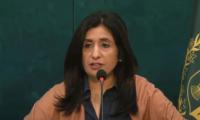ISLAMABAD: Federal Finance Minister Miftah Ismail has said the persistent cash bleeding in the power sector could drown the economy.
“The debt servicing has gone up by 260 per cent; it stood at Rs1,499 billion in the fiscal year 2017-18, but now it is going to stand at Rs3,950 billion,” he said while addressing the National Budget Conference 2022-23 organised by the Mir Khalilur Rahman Memorial Society in collaboration with the ICMA here on Tuesday. He said that by and large, people praised the budget, but there was criticism related to some aspects. He said former PM Imran Khan took 79 per cent of total public debt and liabilities out of the total debt burden in the 75-year history of the country. He said the billing process and collection on account of power sector made it a highly inefficient sector. Electricity prices were not increased last year, so the manufacturers complained how they could collect higher prices for manufactured goods, which they had already sold in the market.
Miftah said he had requested the Central Power Purchase Agency (CPPA) to send a professional to make him understand this complex sector. The professional guided him for one hour and he understood the complex billing mechanism. “I have understood almost all but still need a detailed guidance to understand the issue fully” he added. He said the imported coal prices stood at $300 per ton, but the government was charging $50 per ton, so the remaining $250 per ton were resulting in accumulation of circular debt. The circular debt of the power sector, he said, stood at Rs2,500 billion and outstanding liabilities of the gas sector ballooned to Rs1,500 billion, so the outstanding amount was hovering in the range of Rs4,000 billion. This whopping amount of Rs4,000 billion was off the books, but ultimately it had to be put into the books.
He said there were stocks of Rs2,500 billion in the power sector, but there was a flow of Rs1,100 billion on account of payment of subsidies. So the total accumulation in the shape of circular debt and subsidies consumed Rs1,600 billion alone in the outgoing fiscal year. He said the country’s power plants were efficient, but the fixation of pricing and late billing collection caused inefficiencies in the power sector. He dispelled the impression that the capacity payment was a major problematic area and stated that the total capacity cost was just 15 per cent. There was a problem of those power plants running on furnace oil on the basis of 1950-built plants. “If the power sector is not reformed, it can drown the national economy,” he said.
Earlier, Federal Planning Minister Ahsan Iqbal said the country plunged into a debt trap mainly because of inconsistency in policies. He said he had worked to develop the Vision 2010 in 1997 and then the Vision 2025 after winning the 2013 elections, but the elected government was derailed. "The disruption in the democratic process made the country an experiment place," he said, adding that now the debt servicing burden touched new peaks, indicating that it was unsustainable.
He said out of Rs7,000 billion tax revenues projected to be collected by the FBR, the government had to utilise Rs4,000 billion as debt servicing after transferring shares to provinces to the tune of Rs4,000 billion, so the deficit started from the day one. The development and defence spending stood at Rs1,000 billion each in 2017-18, but now the development allocations remained almost 50 per cent less when compared to defence allocations. He said the government focused on youth and higher education in the budget 2022-23.
Besides, prime minister will hold meeting with Crown Prince, who is also prime minister of KSA
Extended BDS programme is expected to enhance global recognition of Pakistani dental graduates
Bilawal highlighted enduring legacy of Shaheed Zulfikar Ali Bhutto, who founded PPP on November 30, 1967
Interested candidates have been directed to apply online by December 16 next month
She was chairing a special meeting here to review measures for prevention of urban flooding
He recalled discussions about governor’s rule in Sindh occurred daily during previous government of PTI







